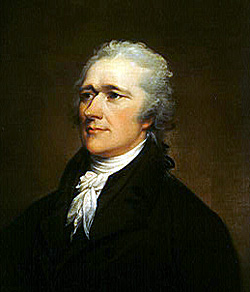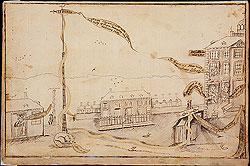People
Alexander Hamilton
1757-1804

Alexander Hamilton
By John Trumbull, 1806. Courtesy National Portrait Gallery, Smithsonian Institute, Washington, DC
From his impoverished boyhood in the West Indies to his untimely death in 1804, Alexander Hamilton exhibited a persistent, unquenchable thirst for fame and honor. In his earliest surviving letter, 14-year-old Alexander confided to his best friend, Edward Stevens
my ambition is prevalent so that I contemn the grovelling condition of a clerk, or the like, to which my fortune &c. condemns me and would willingly risk my life, tho' not my character, to exalt my station…I'm no philosopher, you see, and may be jus[t]ly said to build castles in the air. My folly makes me ashamed, and beg you'll conceal it, yet Neddy we have seen such schemes successful, when the projector is constant. I shall conclude [by] saying I wish there was a war.(1)
Though his initial prospects seemed bleak, Alexander Hamilton's formidable intellectual gifts and drive to succeed caught the attention of patrons who helped him at crucial points in his early career. A subscription fund enabled Hamilton to leave the dreary life of a clerk behind and travel to the mainland British colonies to be educated. It was while attending King's College (today Columbia University) in New York that Hamilton threw himself into the thick of the protests against Great Britain. He wrote arguments condemning British policies and delivered fiery speeches. Significantly, however, even in the midst of these radical activities, the 20-year-old Hamilton(2) revealed sentiments similar to his reactioneleven years later to the Massachusetts Regulation. In a letter to John Jay, Hamilton worried that
n times of such commotion as the present, while the passions of men are worked up to an uncommon pitch, there is great danger of fatal extremes. The same state of the passions which fits the multitude, who have not a sufficient stock of reason and knowledge to guide them, for opposition to tyranny and oppression, very naturally leads them to a contempt and disregard of all authority. 3

A pen-and-ink drawing of a Liberty Pole erected in New York City, about 1770.
As pessimistic as Hamilton was about the abilities even of educated, thinking people to resist the impulse to succumb to revolutionary excesses, he found it "almost impossible among the unthinking populace. When the minds of these are loosened from their attachment to ancient establishment and courses, they seem to grow giddy and are apt more or less to run into anarchy." For the rest of his life, Hamilton exhibited the same mistrust in the abilities of ordinary persons to govern themselves without descending into anarchy.(4)
In April 1775 Alexander Hamilton got his wish for a war in which he could prove his personal bravery and honor. Early in the Revolution, Hamilton gained the admiration and confidence of influential men. Colonel Hamilton quickly became one of General George Washington's most trusted aides. He resigned his post in time to take part in the battle of Yorktown, where he at last had the opportunity to demonstrate his courage and leadership in battle.(5)
As the war wound down, Hamilton resigned his commission and turned his talents and energy to politics and finance. Elected as a representative from New York to the Continental Congress, he assisted Robert Morris, the Superintendent of Finance, to demobilize the Continental Army in 1783, a difficult task since the empty national treasury meant the government could not pay the soldiers. Hamilton quickly became frustrated by Congress' lack of authority under the Articles of Confederation. He left Congress in 1783 and began practicing law in New York.(6)
By 1786, Hamilton was becoming increasingly concerned by what had become a more or less moribund national government. He tried (unsuccessfully) to strengthen the Articles of Confederation, believing that their inherent weakness was a fatal flaw. Hamilton believed that the inability of the national government to shoulder the nation's war debt destabilized the individual states by forcing them to design unrealistic and burdensome tax policies.(7)
The only hope of saving the United States, according to Hamilton, was to scrap the Articles of Confederation and replace them with a stronger federal plan of government. At a poorly-attended meeting of the states at Annapolis, Maryland, in September 1786, Hamilton convinced those present to call for a convention of all the states to be held the following spring, in Philadelphia. The goal, Hamilton wrote, would be to "to render the constitution of the Federal Government adequate to the exigencies of the Union."(8)
The lackluster response to the Annapolis meeting might have been repeated the following spring, but for the violence that erupted in Massachusetts over the fall and winter. To Hamilton, Shays' Rebellion was the direct and inevitable result of the weak national government. The attempt by Massachusetts to pay off its war debts on its own had resulted in a crushing tax burden, especially for farmers unable to produce the required gold or silver currency. The consequence, in Hamilton's mind, was predictable: lawless mobs, assaults on property, and anarchy.(9)
For men like Alexander Hamilton and James Madison, the actions of Daniel Shays, Luke Day and other insurgents could not have come at a better time. Coupled with the desperate tone of reports from General Benjamin Lincoln, General Henry Knox, and others, Shays' Rebellion helped the cause of those arguing for the need to strengthen the national government. Every state sent delegates to Philadelphia except Rhode Island; the most famous and revered man in the United States, George Washington, chaired the deliberations.(10)
Hamilton was one of three New York delegates at the Convention but although he had been central in arranging the gathering, few paid him much heed. Badly shaken as the delegates were by what Elbridge Gerry called "the excess of democracy" many believed had caused Shays' Rebellion, Hamilton's prescriptions were far too anti-democratic for most, such as the presidential appointment of governors, and life terms for the President and United States senators. Hamilton's major contribution to the Constitution was in the essays he wrote in collaboration with James Madison and John Jay, collectively known as the Federalist Papers.
Published in New York newspapers during the ratification debates, the Federalist Papers remain one of the finest discussions of government, its origins and purposes ever published. As he wrote his essays, Hamilton kept in mind the problems in Massachusetts, declaring in Federalist Number 6 that "If Shays had not been a DESPERATE DEBTOR, it is much to be doubted whether Massachusetts would have been plunged into a civil war."(11)
Once twelve states had ratified the Constitution in 1789(12), Hamilton turned his attention to addressing what he believed to have been the underlying cause of Shays' Rebellion and the unrest in other states. As President Washington's Secretary of the Treasury, Hamilton produced his first "Report on the Public Credit" in 1790. Hamilton argued in his report that consolidating the war debt and having the national government assume the responsibility for repaying it would stabilize the states. He also believed that the mere existence of a national debt would tie the states more closely to the government and thus strengthen the union.(13) These ideas were controversial on many levels, and alienated other leaders, including Thomas Jefferson and James Madison. As political factions erupted and hardened along Federalist and Democratic Republican lines, Hamilton's fiscal policies and vision for the new nation remained at the center of the controversy. Personal and political enmity between Aaron Burr, who had served as vice president under Thomas Jefferson, and Hamilton took a tragic turn when Burr shot and mortally wounded Hamilton in a duel at Weehawken, New Jersey in 1804.(14)
About This Narrative
Note: All narratives about people are, to the extent possible, based on primary and secondary historical sources.
See Further Reading for a list of sources used in creating this narrative. For a discussion of issues related to telling people's stories on the site, see: Bringing History to Life: The People of Shays' Rebellion
| Print | Top of Page